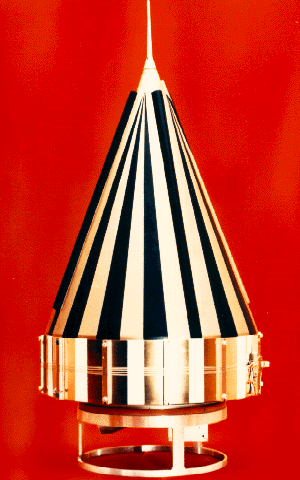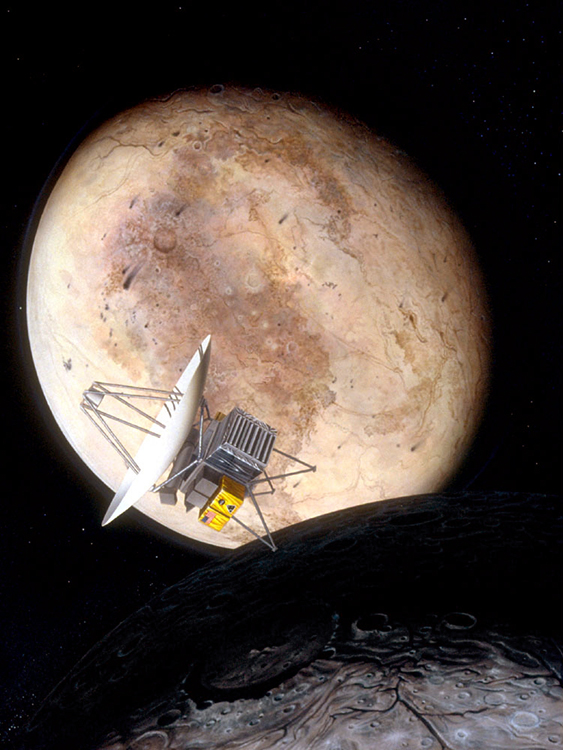|
Mariner Mark II
Mariner Mark II was NASA's planned family of unmanned spacecraft for the exploration of the outer Solar System that were to be developed and operated by JPL between 1980 through the year 2010. Summary After the "flagship" multibillion-dollar missions of the 1970s, in the 1980s NASA was looking for a new, more affordable direction for the 1990s and beyond. Two projects were conceived by NASA's Solar System Exploration Committee in 1983, the Planetary Observer program, and Mariner Mark II. The Observer program, starting with the Mars Observer, was envisioned as a series of low-cost missions to the inner Solar System, based on commercial Earth satellites, while the Mariner Mark II was to be a series of large spacecraft for the exploration of the outer Solar System. Mariner Mark II spacecraft were to use common design, hardware and software solutions, much of it derived from previous missions such as Voyager and Galileo as well as select new technologies, such as advanced gyrosc ... [...More Info...] [...Related Items...] OR: [Wikipedia] [Google] [Baidu] |
CRAF
CRAF may refer to: * Canadian Charter of Rights and Freedoms * Civil Reserve Air Fleet * Comet Rendezvous Asteroid Flyby * Committee on Radio Astronomy Frequencies * Cuban Revolutionary Armed Forces See also * C-Raf RAF proto-oncogene serine/threonine-protein kinase, also known as proto-oncogene c-RAF or simply c-Raf or even Raf-1, is an enzyme that in humans is encoded by the ''RAF1'' gene. The c-Raf protein is part of the ERK1/2 pathway as a MAP kinase ( ..., a human enzyme encoded by the RAF1 gene {{disambiguation ... [...More Info...] [...Related Items...] OR: [Wikipedia] [Google] [Baidu] |
Rosetta Space Probe
''Rosetta'' was a space probe built by the European Space Agency launched on 2 March 2004. Along with ''Philae'', its lander module, ''Rosetta'' performed a detailed study of comet 67P/Churyumov–Gerasimenko (67P). During its journey to the comet, the spacecraft performed flybys of Earth, Mars, and the asteroids 21 Lutetia and 2867 Šteins. It was launched as the third cornerstone mission of the ESA's Horizon 2000 programme, after ''SOHO'Cluster'' and ''XMM-Newton''. On 6 August 2014, the spacecraft reached the comet and performed a series of manoeuvers to eventually orbit the comet at distances of . On 12 November, its lander module ''Philae'' performed the first successful landing on a comet, though its battery power ran out two days later. Communications with ''Philae'' were briefly restored in June and July 2015, but due to diminishing solar power, ''Rosetta'' communications module with the lander was turned off on 27 July 2016. On 30 September 2016, the ''Rosetta'' spacec ... [...More Info...] [...Related Items...] OR: [Wikipedia] [Google] [Baidu] |
Cancelled Spacecraft
Cancel or cancellation may refer to: *Flight cancellation and delay, not operating a scheduled flight Sociology * Cancel culture, boycott and ostracism calling out offensive behavior on social media or in real life Technology and science *Cancel leaf, a bibliographic term for replaced leaves in printed books *Cancellation property, the mathematical property if ''a''×''b'' = ''a''×''c'' then ''b'' = ''c'' **Cancelling out, a technique for simplifying mathematical expressions *Catastrophic cancellation, numerical error arising from subtracting approximations to nearby numbers *Noise cancellation, a method for reducing unwanted sound *Phase cancellation, the effect of two waves that are out of phase with each other being summed *Cancel message, a special message used to remove Usenet articles posted to news servers *Cancel character, an indication that transmitted data are in error or are to be disregarded * Resolution rule, in propositional logic a valid inference rule t ... [...More Info...] [...Related Items...] OR: [Wikipedia] [Google] [Baidu] |
NASA Programs
This is a list of NASA missions, both crewed and robotic, since the establishment of NASA in 1958. There are over 80 currently active science missions. X-Plane program Since 1945, NACA (NASA's predecessor) and, since 1958, NASA have conducted the X-Plane Program. The program was originally intended to create a family of experimental aircraft not intended for production beyond the limited number of each design built solely for flight research. The first X-Plane, the Bell X-1, was the first rocket-powered airplane to break the sound barrier on October 14, 1947. X-Planes have set numerous milestones since then, both crewed and unpiloted. Human spaceflight NASA has successfully launched 166 crewed flights. Three have ended in failure, causing the deaths of seventeen crewmembers in total: Apollo 1 (which never launched) killed three crew members in 1967, STS-51-L ( the ''Challenger'' disaster) killed seven in 1986, and STS-107 ( the ''Columbia'' disaster) killed seven more ... [...More Info...] [...Related Items...] OR: [Wikipedia] [Google] [Baidu] |
Proposed NASA Space Probes
Proposal(s) or The Proposal may refer to: * Proposal (business) * Research proposal * Proposal (marriage) * Proposition, a proposal in logic and philosophy Arts, entertainment, and media * ''The Proposal'' (album) Films * ''The Proposal'' (1957 film), an Australian television play based on Chekhov's 1890 play * ''The Proposal'' (2001 film), starring Nick Moran, Jennifer Esposito, and Stephen Lang * ''The Proposal'' (2009 film), starring Sandra Bullock and Ryan Reynolds * ''The Proposal'' (2022 film), starring Joe Joseph and Amara Raja * " La propuesta" ("The Proposal"), a short story in the 2014 Argentina anthology film ''Wild Tales'' Literature * ''Proposals (play)'', a 1997 play by Neil Simon * ''The Proposal'' (novel), 1999 and 35th book in the ''Animorphs'' series by K.A. Applegate * ''The Proposal'', alternative title of Chekhov's 1890 play ''A Marriage Proposal'' Television * ''The Proposal'' (American TV series), a 2018 reality dating series * The Proposal (Aust ... [...More Info...] [...Related Items...] OR: [Wikipedia] [Google] [Baidu] |
United States National Academy Of Sciences
The National Academy of Sciences (NAS) is a United States nonprofit, non-governmental organization. NAS is part of the National Academies of Sciences, Engineering, and Medicine, along with the National Academy of Engineering (NAE) and the National Academy of Medicine (NAM). As a national academy, new members of the organization are elected annually by current members, based on their distinguished and continuing achievements in original research. Election to the National Academy is one of the highest honors in the scientific field. Members of the National Academy of Sciences serve '' pro bono'' as "advisers to the nation" on science, engineering, and medicine. The group holds a congressional charter under Title 36 of the United States Code. Founded in 1863 as a result of an Act of Congress that was approved by Abraham Lincoln, the NAS is charged with "providing independent, objective advice to the nation on matters related to science and technology. ... to provide scie ... [...More Info...] [...Related Items...] OR: [Wikipedia] [Google] [Baidu] |
Pioneer Program
The Pioneer programs were two series of United States lunar and planetary space probes exploration. The first program, which ran from 1958 to 1960, unsuccessfully attempted to send spacecraft to orbit the Moon, successfully sent one spacecraft to fly by the Moon, and successfully sent one spacecraft to investigate interplanetary space between the orbits of Earth and Venus. The second program, which ran from 1965 to 1992, sent four spacecraft to measure interplanetary space weather, two to explore Jupiter and Saturn, and two to explore Venus. The two outer planet probes, ''Pioneer 10'' and ''Pioneer 11'', became the first two of five artificial objects to achieve the escape velocity that will allow them to leave the Solar System, and carried a golden plaque each depicting a man and a woman and information about the origin and the creators of the probes, in case any extraterrestrials find them someday. Naming Credit for naming the first probe has been attributed to Stephen A. Sal ... [...More Info...] [...Related Items...] OR: [Wikipedia] [Google] [Baidu] |
Mariner Program
The Mariner program was conducted by the American space agency NASA to explore other planets. Between 1962 and late 1973, NASA's Jet Propulsion Laboratory (JPL) designed and built 10 robotic interplanetary probes named Mariner to explore the inner Solar System - visiting the planets Venus, Mars and Mercury for the first time, and returning to Venus and Mars for additional close observations. The program included a number of interplanetary firsts, including the first planetary flyby, the planetary orbiter, and the first gravity assist maneuver. Of the 10 vehicles in the Mariner series, seven were successful, forming the starting point for many subsequent NASA/JPL space probe programs. The planned Mariner Jupiter-Saturn vehicles were adapted into the Voyager program, while the Viking program orbiters were enlarged versions of the Mariner 9 spacecraft. Later Mariner-based spacecraft include Galileo and Magellan, while the second-generation Mariner Mark II series evolved into th ... [...More Info...] [...Related Items...] OR: [Wikipedia] [Google] [Baidu] |
Neptune Orbiter
Neptune Odyssey is an orbiter mission concept to study Neptune and its moons, particularly Triton. The orbiter would enter into a retrograde orbit of Neptune to facilitate simultaneous study of Triton and would launch an atmospheric probe to characterize Neptune's atmosphere. The concept is being developed as a potential large strategic science mission for NASA by a team led by the Applied Physics Laboratory at Johns Hopkins University. The current proposal targets a launch in 2033 using the Space Launch System with arrival at Neptune in 2049, although trajectories using gravity assists at Jupiter have also been considered with launch dates in 2031. The mission concept was considered for possible recommendation as a mission priority in the 2023–2032 Planetary Science Decadal Survey, however for logistical reasons the Uranus Orbiter and Probe mission was selected as the ice giant orbiter mission recommendation, with top priority ahead of the Enceladus Orbilander. Backgrou ... [...More Info...] [...Related Items...] OR: [Wikipedia] [Google] [Baidu] |
New Horizons
''New Horizons'' is an Interplanetary spaceflight, interplanetary space probe that was launched as a part of NASA's New Frontiers program. Engineered by the Johns Hopkins University Applied Physics Laboratory (APL) and the Southwest Research Institute (SwRI), with a team led by Alan Stern, the spacecraft was launched in 2006 with the primary mission to perform a Planetary flyby, flyby study of the Pluto system in 2015, and a secondary mission to fly by and study one or more other Kuiper belt objects (KBOs) in the decade to follow, which became a mission to 486958 Arrokoth. It is the List of artificial objects leaving the Solar System, fifth space probe to achieve the escape velocity needed to leave the Solar System. On January 19, 2006, ''New Horizons'' was launched from Cape Canaveral Space Force Station by an Atlas V rocket directly into an Earth-and-solar Escape velocity, escape trajectory with a speed of about . It was the fastest (average speed with respect to Earth) man ... [...More Info...] [...Related Items...] OR: [Wikipedia] [Google] [Baidu] |
Pluto Kuiper Express
''Pluto Kuiper Express'' was an interplanetary space probe that was proposed by Jet Propulsion Laboratory (JPL) scientists and engineers and under development by NASA. The spacecraft was intended to be launched to study Pluto and its moon Charon, along with one or more other Kuiper belt objects (KBOs). The proposal was the third of its kind, after the ''Pluto 350'' and a proposal to send a Mariner Mark II spacecraft to Pluto. Originally conceived as ''Pluto Fast Flyby'', and later briefly named ''Pluto Express'', the mission was inspired by a 1991 United States Postal Service stamp that branded Pluto as "Not Yet Explored". The project brought on JPL engineers and students from the California Institute of Technology and, later, Alan Stern and other scientists from the Pluto 350 project. While the project was initiated in 1992, the project's development phase was lengthy, spending nearly a decade in the proposal and funding stage. During planning, the mission was changed to includ ... [...More Info...] [...Related Items...] OR: [Wikipedia] [Google] [Baidu] |

.png)




